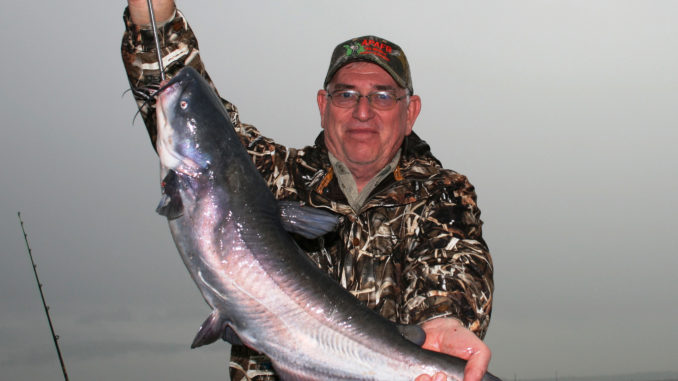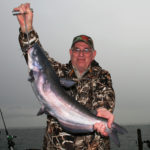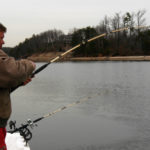
Weather conditions will dictate January bite
Some outdoorsmen around the Santee Cooper lakes believe that January is just a slow-motion repeat of December. However there’s actually much more to it than that.
With the end of deer season, a lot of hunters will start what other have been doing in December: hunting waterfowl. The cold weather typical of January often brings in more waterfowl, and the hunting is sometimes exceptional.
The seasons, shooting hours, limits and other special restrictions on migratory bird hunting are set by the S.C. Department of Natural Resources in accordance with guidelines set by the U.S. Fish and Wildlife Service. Information is available in SCDNR’s regulations digest, but you need to become very familiar with information on the seasons and restrictions provided in a separate Migratory Bird Brochure — a “must read” to ensure you know specific limits for different species. Plus, you need to know the refuge boundaries and stay completely away from those areas. But good waterfowl hunting is certainly available, and there are plenty of open areas to hunt.
According to the SCDNR, a few rules for hunting migratory waterfowl are worth remembering. Shotguns must be plugged to hold no more than three shells; baiting or hunting over bait is strictly prohibited; hunting ends at official sunset; the possession of lead shot is prohibited while waterfowl hunting; in addition to a migratory bird permit (HIP), a S.C. Migratory Waterfowl Permit and Federal Waterfowl Stamp are required for hunting ducks, geese and brant. Electronic Federal Waterfowl Stamps are not valid in SC.
As for the fishing, January is often a time of change, and according to retired guide Don Drose, it is usually weather-dependant.
Drose was still actively guiding last January, and he said last year’s warmer weather helped the striped bass fishing remain very good well into the month. But often, there’s a point in January when the water temperature drops and the striper fishing slows. Drose said that’s usually when the catfishing perks up, and targeting blue catfish can be sensational.
If water temperatures allow striper activity to continue, fishermen such as Drose will locate schools of shad by looking for signs of gull activity or simply using a depth finder to find the forage fish. Typically, the stripers will be around the forage this time of year, and threadfin shad is a favored bait for Drose. Live herring is also a good bait and one that is used a lot on Lake Moultrie near the Pinopolis Dam. January can be a great time to catch big stripers that are well in excess of the 26-inch size limit.
If colder weather arrives and shuts down the stripers, it actually triggers a bite for blue catfish.
Buster Rush guides for catfish and crappie, and he said that when the crappie fishing slows in January, he will focus on blue catfish. Rush said action is usually outstanding on both Lakes Marion and Lake Moultrie, but he primarily fishes the mid-to lower-portion of Lake Marion.
“I’ll focus my efforts where I find a combination of drops and big schools of shad,” Rush said. “Typically at this time of the year, the threadfin shad will cluster into huge schools, and the blue catfish will be there, feeding on them. I prefer to locate a combination of shad along a drop. Also, certain areas along the main-river channel are good, plus the lower end of the lake has lots of deeper holes scattered throughout the mid-lake area that are productive. But sometimes, just finding a big school of shad will be all you need.”
Rush (803-432-5010) likes to use cut herring and shad as his primary baits, although cut perch is also a very good bait. He said anchoring and fan-casting around the boat is his favored method, but vertical fishing over a school of shad and drift fishing can be productive techniques.
“The right technique will vary from day to day, depending on what the fish, forage and weather are doing,” he said. “Sometimes, the fish will be scattered in a general area around the forage, and it’s best to anchor and fan-cast. This is especially true if you’re in the area where there are lots of trees and stumps in the lake. You can effectively cover a large area around the boat using this method. But if I don’t get a bite pretty quick, I’ll move.
“If I get on a tight group of fish in a small area, I can drop the bait straight down to a specific depth if they are hovering just off the bottom. Usually, the bigger fish will be holding just under the school of shad with smaller fish in the shad school.”
Of significance to many on the Santee Cooper lakes, there are plans for a season to reduce the occurrence and minimize the risk of adverse impacts to public resources including fish, wildlife, plants and their habitats caused by double-crested cormorants. Cormorants are protected by the Migratory Bird Treaty Act, and special permission has been obtained by the SCDNR for this removal. According to Derrell Shipes, chief of statewide wildlife projects for SCDNR, special training will be required for persons to obtain permits to hunt cormorants; sessions will be on Jan. 7 at 6 p.m. and Feb. 8 at 2 p.m. at the Santee Cooper Auditorium on Santee Cooper headquarters in Moncks Corner.
According to Shipes, the cormorant season will begin after waterfowl season closes and will extend from Feb. 2, 2014 through March 31. Hunting will be allowed in areas that were only open to waterfowl hunting, but only cormorants can be taken. There is a lot more information coming on this special season.







Be the first to comment